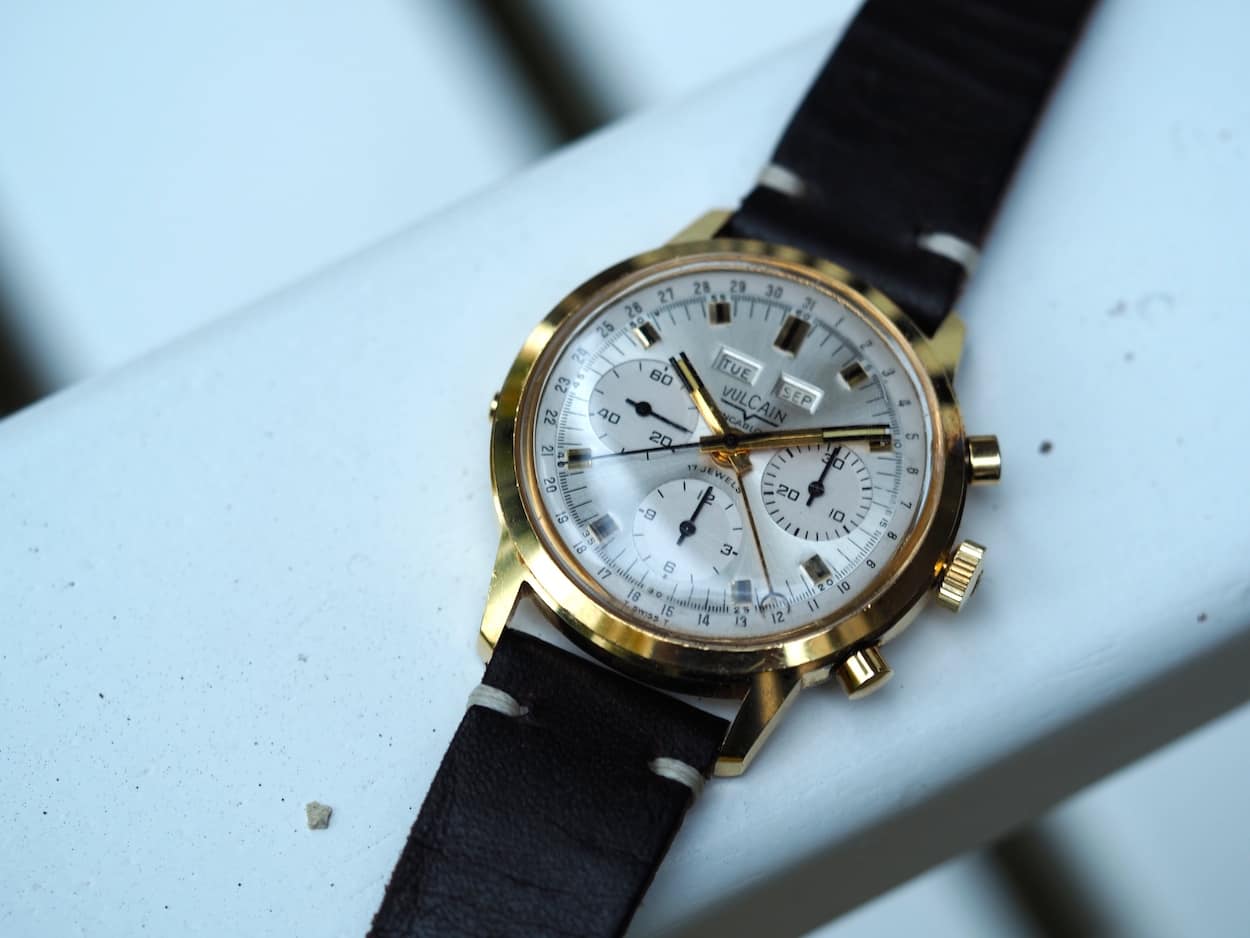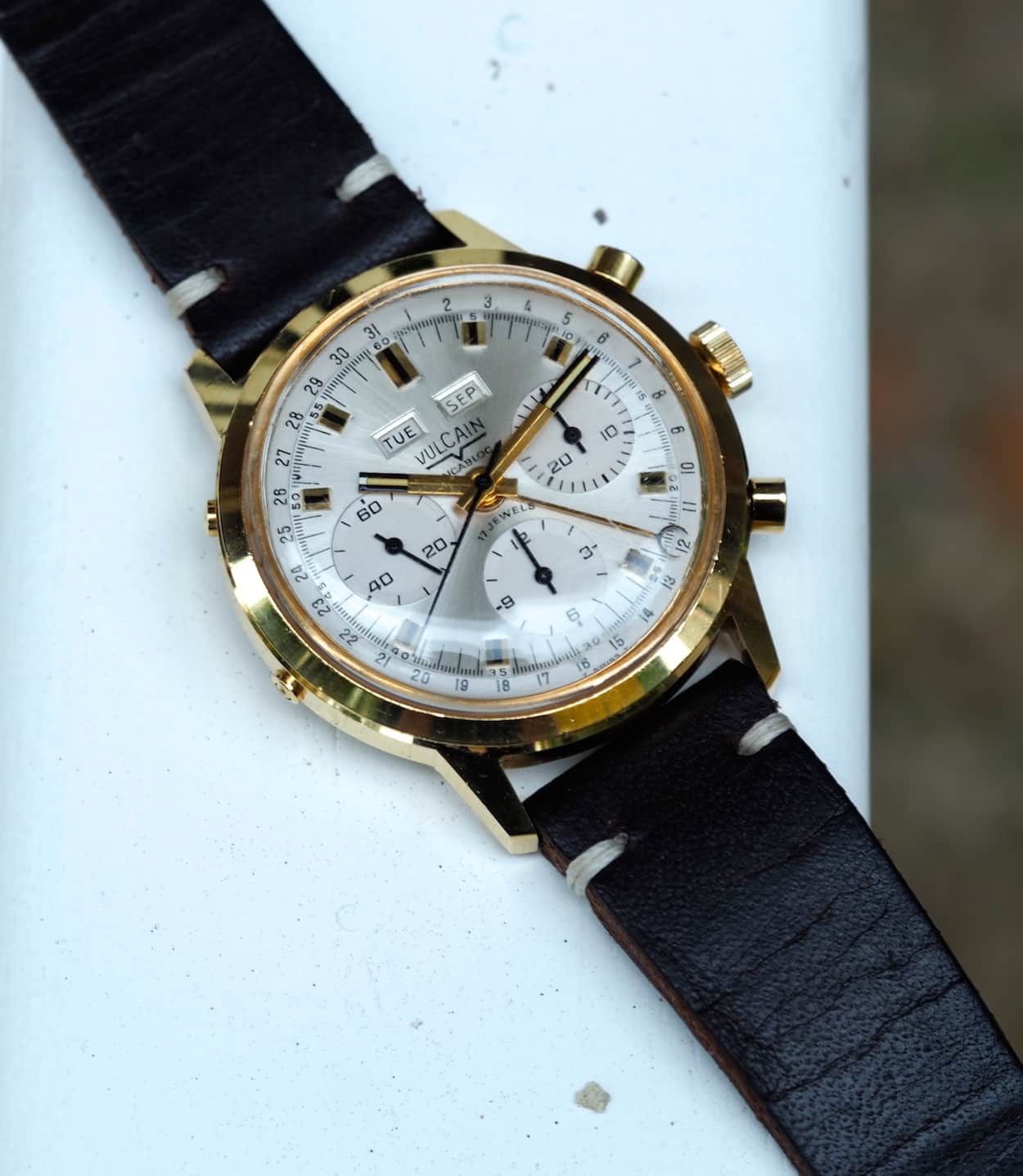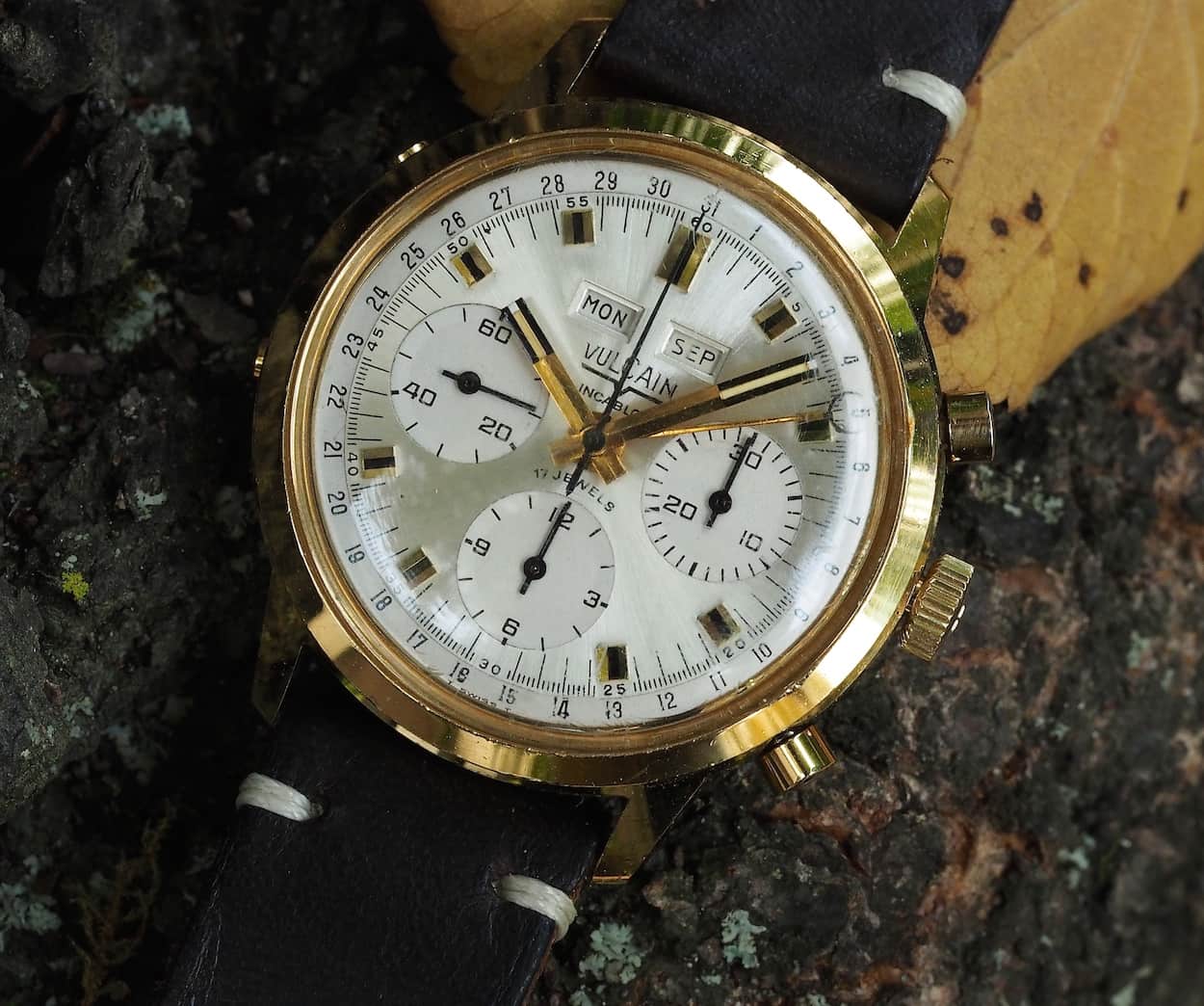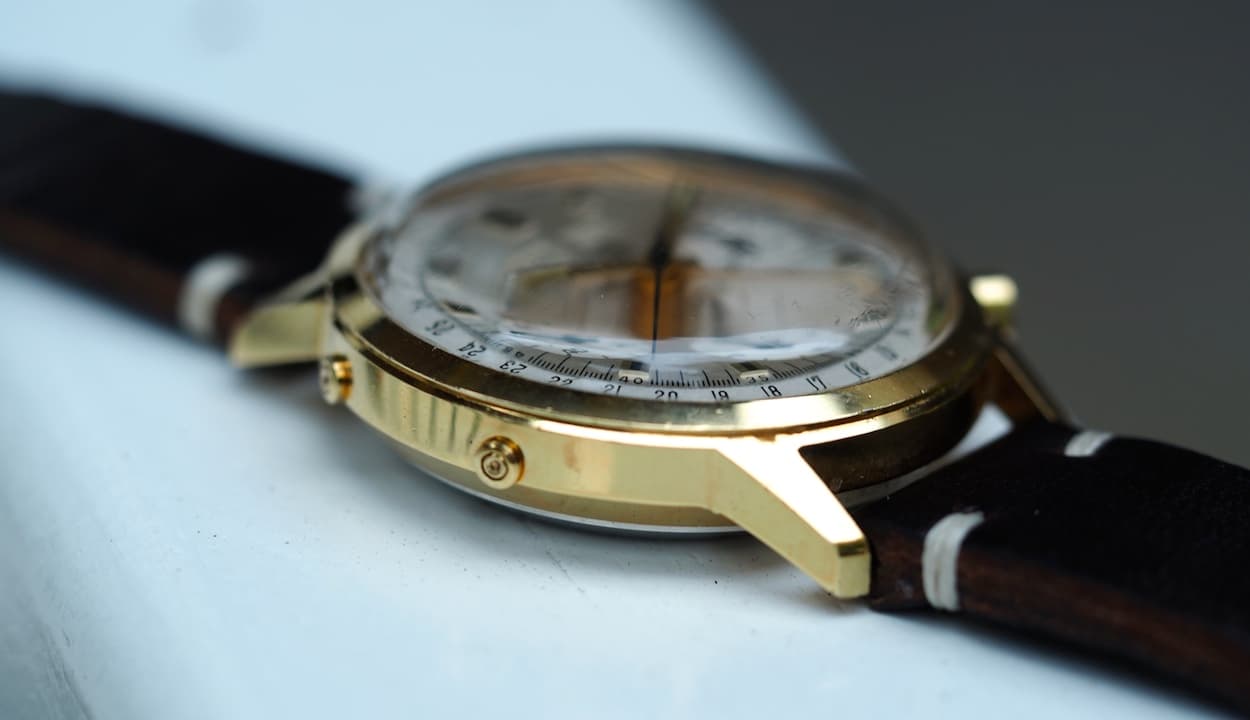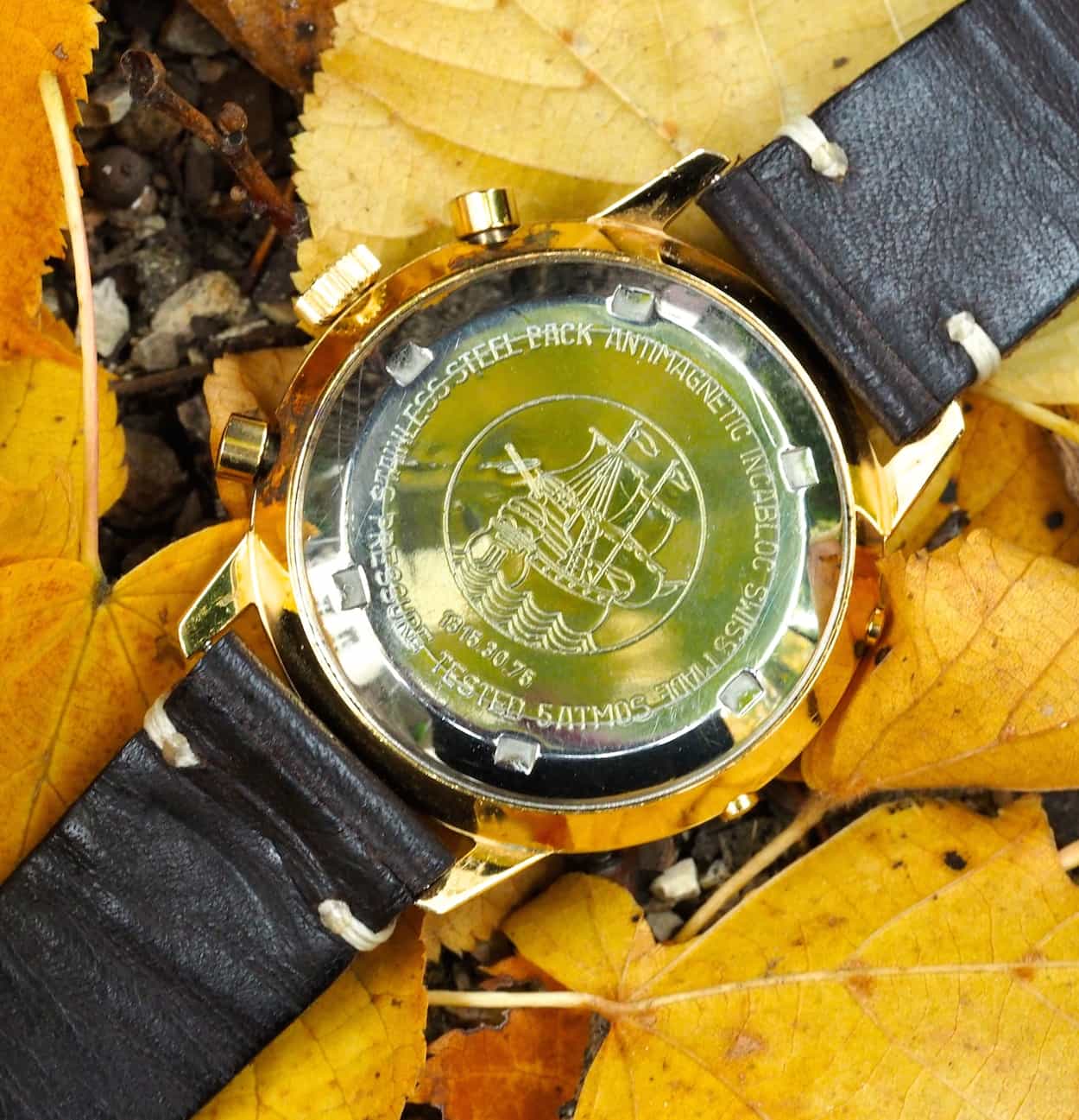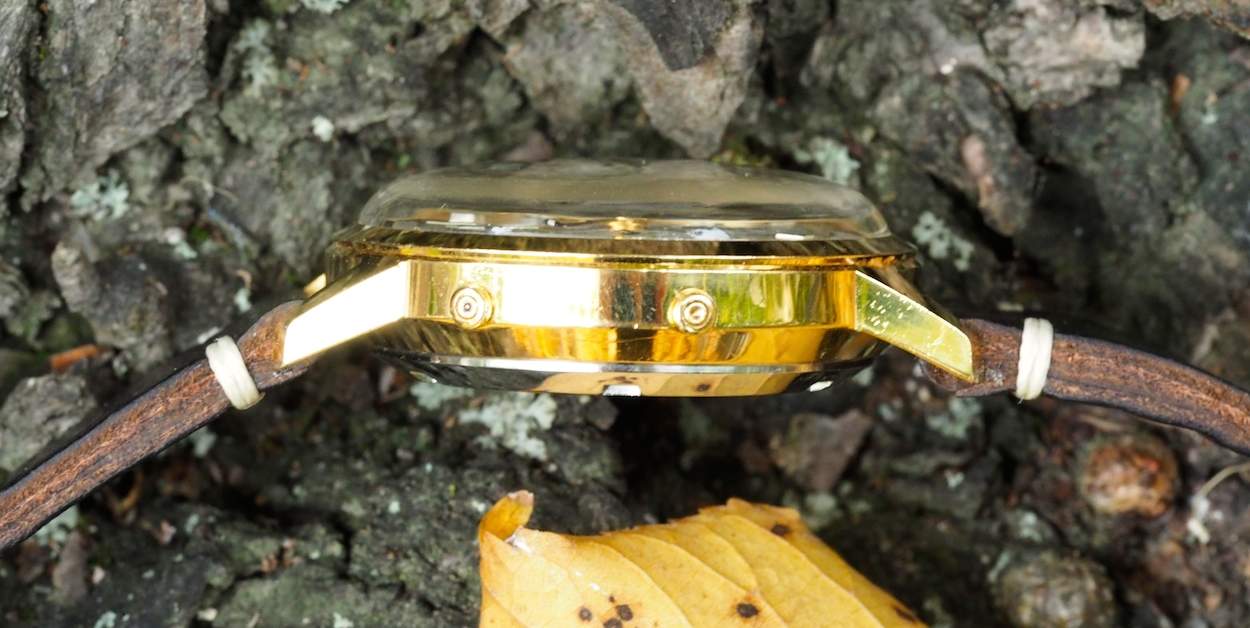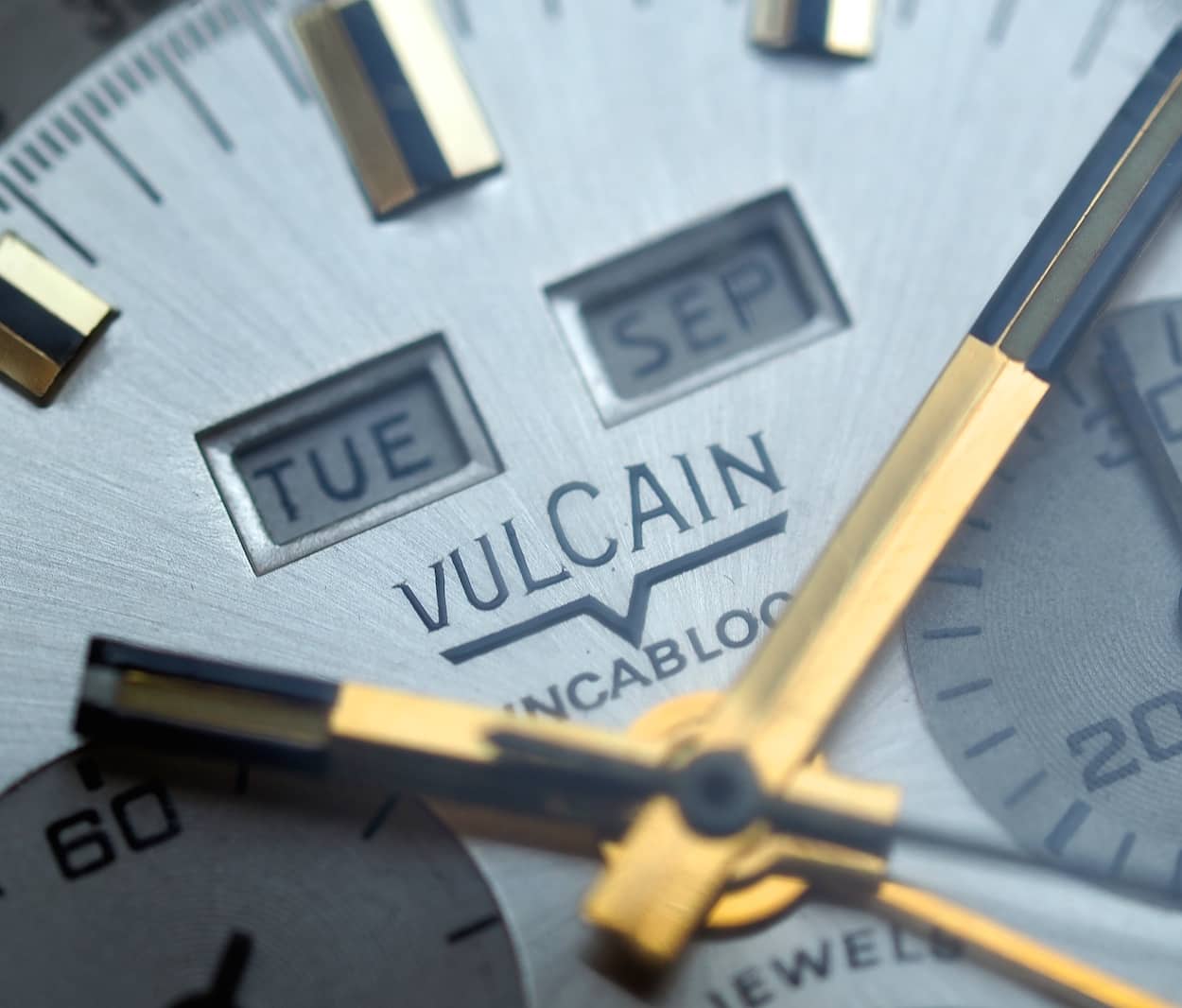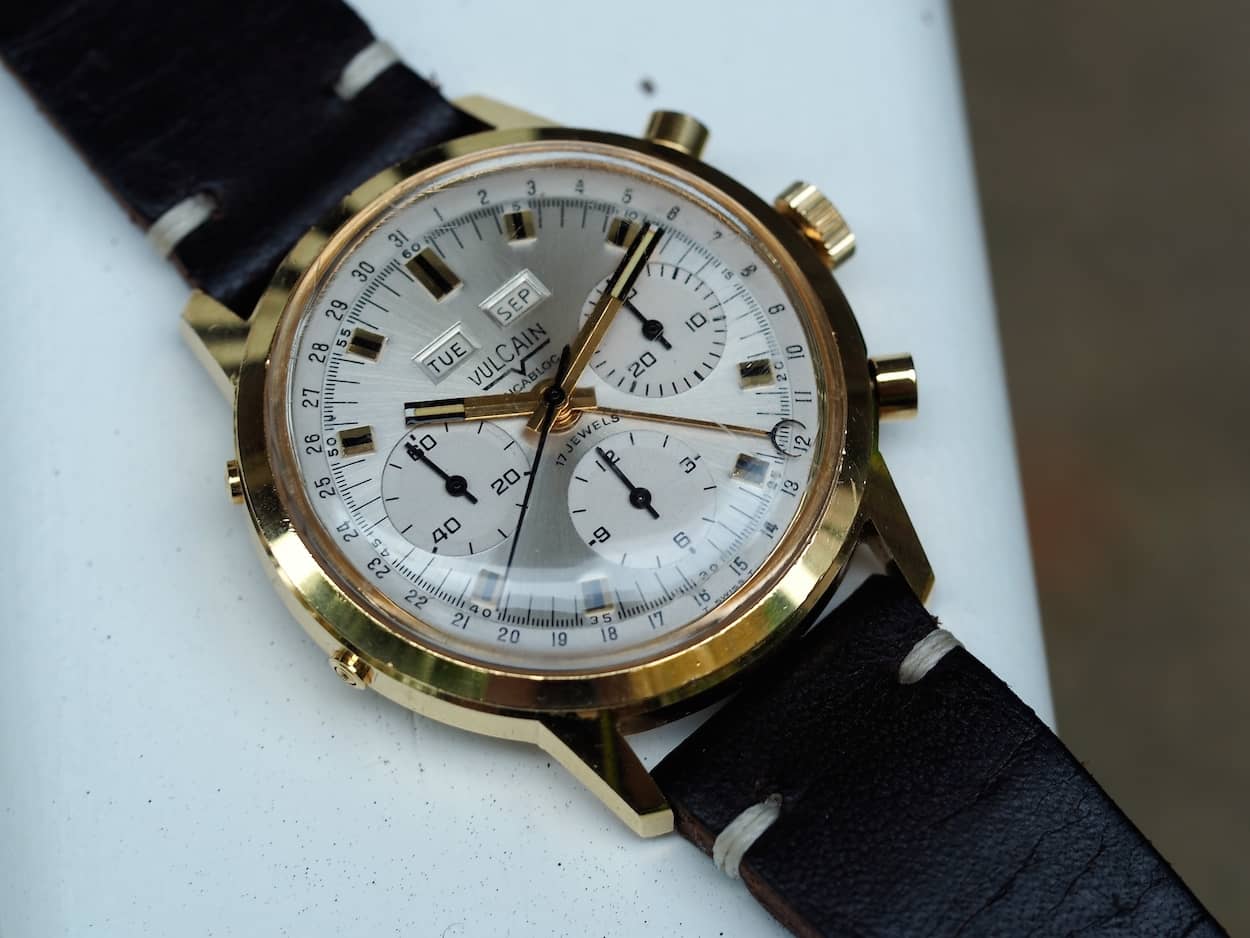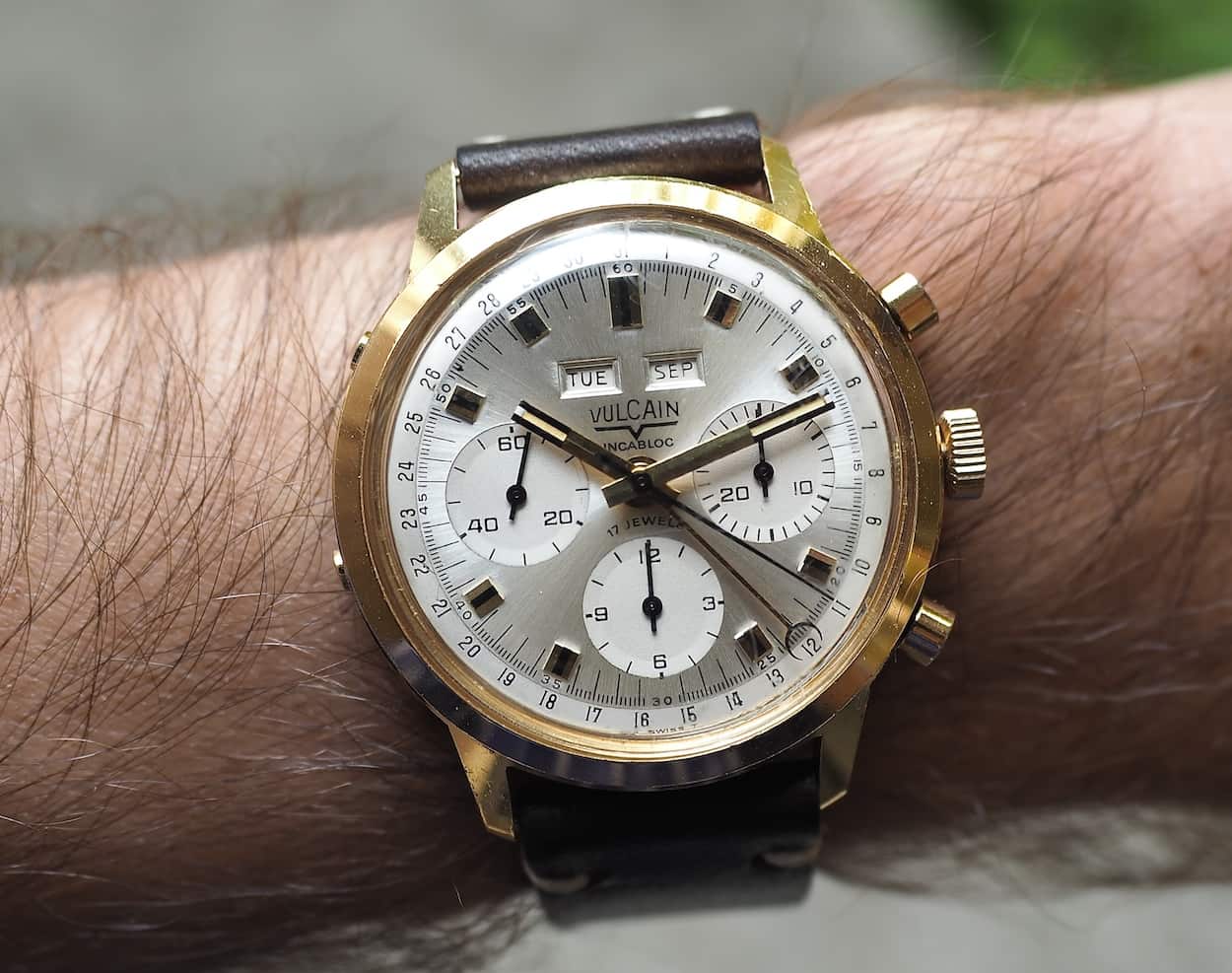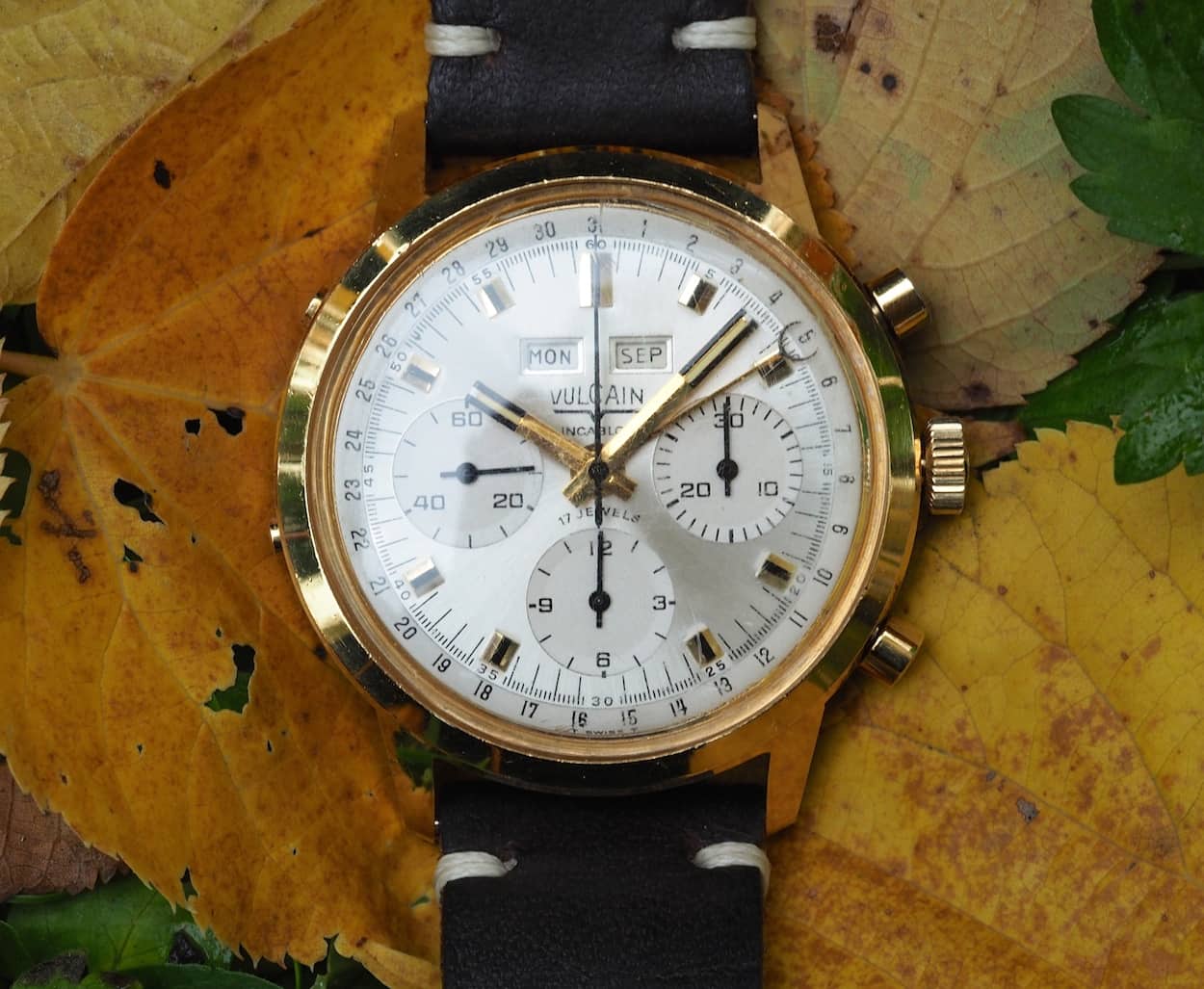#TBT Vulcain Triple Date Chronograph
Gold. It’s a metal, especially in its yellow tone that, in my lifetime, has never really been attractive to me. The fact that I’ve been on this Earth for less than 40 years likely speaks volumes about that, though. It’s odd because I remember gold being the, well, gold standard when I was at a very young age, but I actually equated the metal with those of a much older age. My Grandfather generally wore a gold watch, as did my Uncles and so on. Even my Dad wore one at times, but he normally wore steel as it was less flashy and suited his active lifestyle more aptly. Later, when I entered middle school, some of the other pubescent “tweens” began donning gold chains, but that quickly shifted to silver. But in over 30 years, yellow gold has never really returned in the full force that it enjoyed in the 50’s through the mid 80’s. Whether this is due to the high cost of the metal, the flashy/dressy nature of the pieces in a far more casual/sporty society, or a permanent change in tastes, it is interesting. What I am now realizing, though, is that the metal, especially when in a plated or “filled” format, represents a classy bargain for the vintage hunter. One can often find the same “innards” as their stainless counterparts at a massive discount. Aberrations exist, of course, should you decide to consider to older Rolex Sport watches like the Submariner or Daytona, but “old Gold” is generally a nice deal because it’s not so popular. So, it was this value-minded approach that led me to today’s #TBT piece. It’s a big, beautiful piece from the late 60’s/early 70’s and it was dirt-cheap considering its qualifications. Grab a “smoke and a pancake” because it’s Goldmember time on #TBT…here comes the Vulcain Triple Date Chronograph!
Sorry for the Austin Powers reference. I could have gone the classy direction and cited something from Auric Goldfinger in the classic Bond thriller, but the opportunity to throw a little jab at my Dutch compatriots was too succulent to resist! (And by the way, for a little more gold from this week, check out Robert-Jan’s review on the Seamaster 300 in Sedna and Ti.) In any case, yes, I bought a gold-plated watch. The Vulcain Triple Date you see before you is a real honey of a watch and I’m really going to do my best to convince you to consider it in the same vein as its stainless counterparts. Shall we?
First off, what is a triple date? It’s a good question because the name might suggest that that the watch shows three different dates or some other information. Actually, the watch is a standard, tri-compax layout chronograph with some fairly serious modifications to the movement to give you date information. And when it comes to date information, this is where the “triple” comes in as the watch shows the day, date and month. The day and month are shown within little windows below 12:00 while the date is indicated on the outer edge of the dial with the “crescent moon” shaped hand. The movement employed and how to set all these things are something I’ll cover shortly.
If you were looking at this Vulcain Triple Date thinking that it looks similiar to some other triple date chronographs, you’d be correct. It shares the same case as the more prevalent, and well-known, Wakmann Triple Dates as well as Gigandet and even Jules Jurgensen. In fact, Gigandet actually made the watches and branded them for these other marques. Remember, the late 1960’s and 1970’s were wild and wooly times for Swiss watch companies and the sharing we so often discuss was running rampant.
The Vulcain before you is gold plated base metal with a stainless screw-down case back, but chrome-plated versions were available as well. It sits at a big bold diameter of roughly 39.5mm with a very convenient 20mm lug width. It’s also a chunky piece with a thickness of roughly 12.1mm. Note that this is the later case style and early pieces were stainless, 37mm and had 19mm lugs. The design of the earlier pieces, by the way, is a bit les bold as the lugs flow more gradually from the case. Today’s piece has some fairly strong lugs that stem from a perfectly round case design. It’s still classic looking, but definitely larger looking than its predecessor. Then there’s the movement and that’s obviously the major part of the charm…
The original triple date chronographs made do with a Valjoux 72C where the “C”, I’m guessing, stood for calendar. The movement was based on the tried and true Valjoux 72 that we’ve featured so heavily on #TBT. In the case of the 72C, it functioned exactly like today’s piece, but the subject Vulcain Triple Date actually received an updated version of the movement called the Valjoux 730. While the 72C was a fine movement with excellent finishing, it really was an extension of the 72C in that it ran at 18,000 bph.
The 730, on the other hand, ushered in “higher-beat” technology at 21,600 bph. Balance wheel updates and micro-regulator changes were also implemented to create a highly accurate heartbeat in a package that some see as one of the finest hand wound movements in history.
Despite all the functionality, using the Vulcain Triple Date is relatively easy. The chronograph functions work per normal with the capped pushers with stop/start up top and reset below. The manual winding crown is aptly sized and sets time as usual. On the opposite side of the watch is where things get interesting. Changes to the date should not be made between 10pm and 2am as the gears will be in motion to execute a change and can be damaged by manual meddling. Two small nearly flush buttons reside and these control the “triple functionality” of the watch. A toothpick works well for these pushers so as not to scratch the case. The lower button changes advances the central date hand one day at a time with a nice, firm click. The upper button advances the apertures found on the dial. Interestingly, this button has two detents. A push all the way advances the month by one while also advancing the day of the week. So, the idea is to fix the month and then move the day of the week. In practice, though, pushing to change the day also changes the month (blame a movement that either needs a service or it being a bit buggy). So, in the end, one sets the month and uses the crown to advance through the days of the week…just ensure you keep the centrally mounted date well before where it ultimately needs to be. It sounds awfully confusing, but it really isn’t…
Like a growing human whose tastes mature from ketchup to mustard, my desires have changed from simple 3-handers to chronographs. It took me a long time to get to this point, but I’m obviously a fanatic when it comes to pieces with 2-3 sub registers and I’ll sometimes allow a date window. At this stage, though, it’s normally the end of the road for me. I admire the handiwork involved in super complications and I don’t fault those who wear them, but I just don’t find them attractive. Most importantly, I struggle to read them clearly and I’d likely not know how to use them. So, with this in mind, it’s odd that I’m a big fan of the Vulcain Triple Date. Sure, the Valjoux 72 base doesn’t hurt, but more importantly, I really like the way that all the information is displayed. Everything is so clear and, crucially, the time and the chronograph can still be read. I’m also a fan of the high quality details on the dial. These range from the detailed, applied hour indices, the intricate hour and minute hands, and the delicate crescent-shaped date hand. Finally, nothing against Wakmann, but I really like the Vulcain logo (you can see my other review of a Vulcain here) and it’s a brand that still exists today – and is notable for its Cricket.
Coming back to gold, there are obviously signs of it on the dial, hands, and the case. While I really like the chrome and stainless versions of these watches (no matter the brand), I think gold lends itself well to a watch that’s certainly less sporting than a tachymeter bezel manual wind chronograph. While it’s certainly newer than the legendary Angelus Chronodato, I find the Vulcain Triple Date to fit in a similar class looks-wise and the former certainly looks great in gold.
The Vulcain Triple Date is a big watch on the wrist, but aside from physical size, it has a lot of attributes that really add to its presence. Specifically, there’s not much of a bezel (making the dial appear as quite large) and the white satin dial really catches the light. The thickly domed crystal, also adds to the heft. Finally, you have the bright gold case with some substantial “controls” stemming from the right side. So, with this fairly imposing size, where is this piece best worn? Actually, I find it to be very versatile. In the picture above, I’ve paired it with a brown leather strap with saddle stitching from Giuliano and I think it looks fantastic. I’m also keen to pair it with a racing strap. But, those represent a rather casual look that pairs well with jeans or business casual attire. I also think this watch would work nicely with either black or brown crocodile and that would make it far more formal. Then, the Triple Date becomes more of a dress chronograph. So, yes, this is a very usable piece and, strangely, I think that much of that stems from its case color.
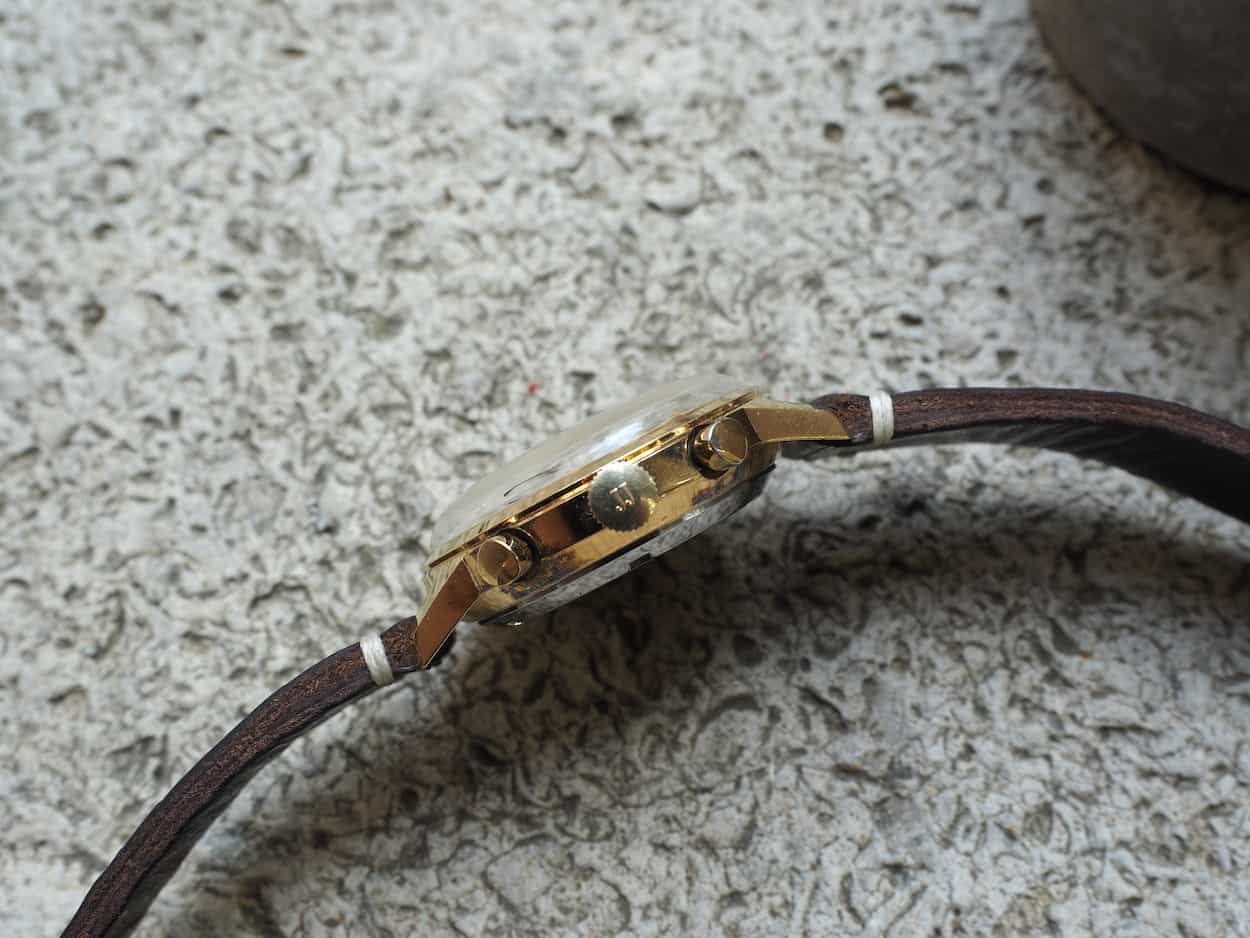
Vulcain Triple Date crown and pushers…the “JJ” is from Jules Jurgensen. Was it installed during production by mistake or later? We’ll never know but JJ had the same watch in their catalog.
My recent buying experience with the Vulcain Triple Date was overwhelmingly positive. I found the piece on eBay and it was a no reserve, normal auction that started at a lowly $0.99. 64 bids later, it ended at $885, which, to me, is an absolute bargain for so much watch. In fact, while the stainless and chrome pieces are now selling anywhere from $1500-2000, the gold plated pieces typically hit the $1200-1400 mark. So, yes, this was a bargain and, yes again, bargains still exist. Some things to look for on these pieces are completeness. You do find, at times, a mish-mash of hands and things on the dial and I’d suspect that finding replacements is difficult. Furthermore, on both the gold and chrome cases, be wary of wear-through to the base metal. I see at least one Wakmann on eBay as of writing that has a lot of base metal exposure. Sure, you can have anything plated but it’s expensive and doesn’t always end well. Regarding the movements, they can be finicky and I’d suggest starting with something that is at least working. Mine runs very well aside from the sticky day/month button, but that doesn’t really put me off. As an aside, you’ll note that my piece contains a “JJ” crown and that presumably stands for “Jules Jurgensen”. We will never know if this caused by someone installing a wrong part at the factory, as Jurgensen sold the same watch, or if it was fitted during a service. Normally speaking, if it’s a Vulcain you’re after, the crown should be unsigned. Also, about that, Vulcains do tend to be more rare than Wakmanns. I don’t think that the market applies much of a premium to this, but keep it in mind should you become frustrated if you don’t find Vulcains on the market.
After picking up the Vulcain Triple Date, I don’t expect to enter a “gold phase” in my watch collecting tenure. However, it’s opened my eyes a bit and I won’t be as dismissive any longer. This watch oozes class and elegance while still achieving the level of sportiness and simplicity that I admire so much in other 60’s/early 70’s chronographs. Plus, it was a steal and you can find countless other examples of classic chronographs that are out there at great prices simply due to their case color and composition. Hopefully, this #TBT article enlightened on you on an interesting watch and also opens up your mind to case colors other than silver too. Until next week…

